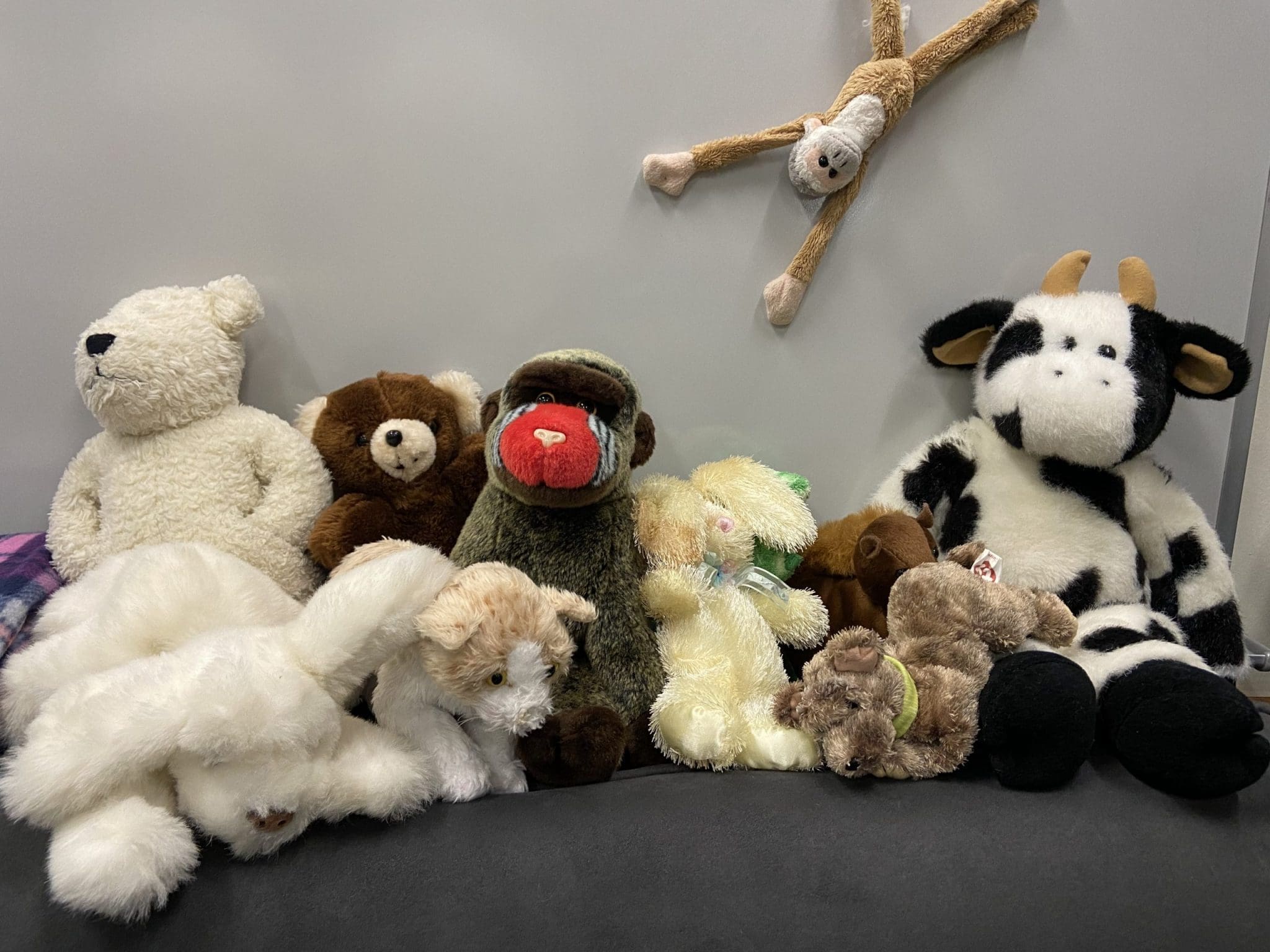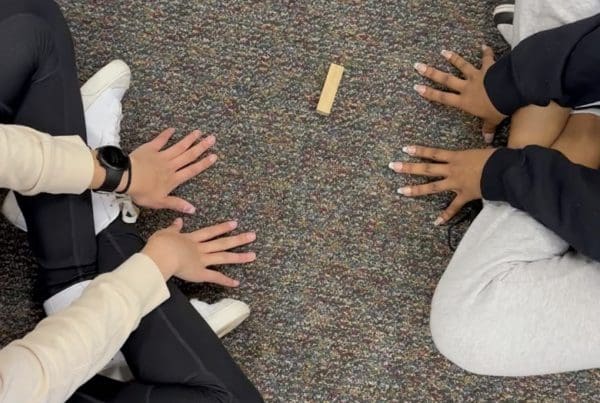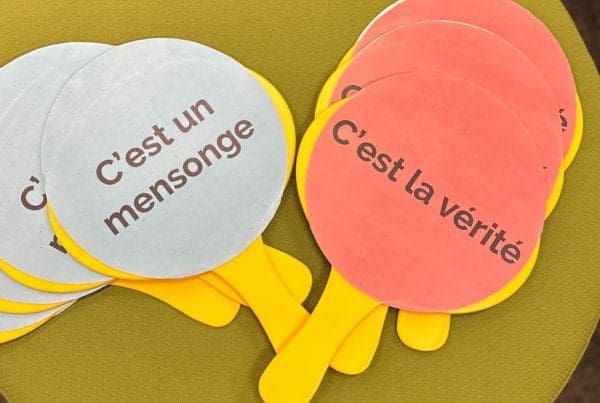Can we agree that knowing each other’s names, correct pronunciation and all, is crucial in building a strong sense of community within any group? Can we also agree that this process can sometimes feel awkward and clumsy? Few adults, let alone adolescents, want to admit that they do not know someone’s name that they’ve been around for any period of time. That’s where the Name Game & Pass the Chicken come in handy! These little- to no-prep activities will gently coax that tangible awkwardness right out of your students as they get to know each other, name and all!
THE NAME GAME
What you need: Several stuffed animals or something small that can easily be thrown around the room. Nothing breakable! I raided my daughters’ stuffed animal collection several years ago, and these precious jewels live in a small tub in my room year-round.
Set-Up: The Greetings… no stuffed animals needed yet!
- Students stand in a circle.
- In the target language, the teacher greets a student across the circle, including their name. (Bonjour, Abdul).
- This student says hello to the teacher before picking a student across the circle to greet.
- The last student greeted will say hello to the teacher, thereby completing the circle.
Helpful Hints:
- For larger classes, divide into 2 or 3 smaller groups.
- Each student will only be greeted once.
Greetings might go something like this:
- Teacher: « Bonjour, Abdul »
- Abdul: « Bonjour, Madame. Bonjour, Kris. »
- Kris: « Bonjour Abdul. Bonjour JJ. »
- JJ: « Bonjour Kris. Bonjour Stella. »
- Stella: « Bonjour, JJ.. Bonjour, Lawson. »
- And so on…
Helpful Hint:
- If students are not wearing name tags, they can ask the name of the person they are greeting. Using the target language for this question is excellent practice during the first weeks of school!
Round One: Add a Stuffy
- The teacher says the name of the student they originally greeted, being sure to make eye contact before gently tossing them a stuffy.
- This student looks at the person they initially greeted, says their name and gently tosses the stuffed animal to that person.
- This continues until the last student looks at the teacher, say his/her/their name and gently tosses the stuffy to complete the circle.
Round Two: Add More Stuffies
- Play again using the order established, gradually adding one stuffed animal at a time.
- Add as many stuffed animals as the group can handle successfully.
Helpful Hints:
- At the beginning of the year, I don’t stop the game if one or two stuffies fall on the ground.
- Once groups are more comfortable with each other, I stop the game immediately when a stuffed animal hits the ground.
- When students throw stuffies inappropriately, I stop the game immediately.
- While I use the game to get students to learn everyone’s name, this activity also requires the group to communicate and work together. Take a look at this video to see the game in action!
Michele Whaley’s class of 5th graders successfully tossed 14 stuffies around the circle without one hitting the ground for an extended period. As of this blog post, my high school students are yet to meet this goal but we are determined to try and are yet to give up.
I credit Michele Whaley for introducing me to The Name Game. It is possible, however, that some incredible individual out there deserves credit for creating this entertaining and practical game that I will forever keep in my arsenal of community-building activities.
PASS THE CHICKEN
What you need: a chicken or something your students can easily pass to one another. I use a plastic-chicken keychain.
Set-Up:
- Students stand in a circle.
- The teacher gives the chicken to a student, indicating they are IT. Volunteers are always welcome.
- The teacher asks the student to name 5 other students in the class – this is just my example number.
- When the teacher says, “pass the chicken,” students start passing the chicken around the circle as quickly as possible.
- The person who is IT, tries to name 5 other students in the class before the chicken makes its way to its starting point.
In the target language, it will go something like this:
«Ava, comment s’appellent 5 autres élèves dans la classe ? Passe le poulet!»
“Ava, what are the names of 5 other students in class? Pass the chicken!”
Helpful Hints:
- I start off small to build confidence by using a low number. Few people like making mistakes in front of others.
- I gradually raise the number as I gauge my students’ comfort level.
- The end goal is for every student to name all their classmates successfully.
Game Variations:
- Name 3 things you learned about the character in the book we read today.
- Name 5 words associated with today’s story or lesson.
- Name 4 things you learned about another student in this class.
Something to think consider:
This is a great activity to do in the middle or end of class once students know each other’s names. It is the perfect way to wrap up a lesson and get students out of their seats. While you could eliminate students who are not successful, I tend not to. Instead, I give them props for trying!
Once again, I have to credit Michele Whaley for teaching me this entertaining activity. She tells me, however, that the original post for this little gem can be read here.
If you want to see a short video of my students playing both The Name Game & Pass the Chicken, click here!






Thank you for posting, true, stuffed toys they love them of all ages. For the morning circle, I Use a ball. Pass the ball in different ways, greetings, to introduce themselves or ask about a name or if they like to play basketball or soccer at this point I use the balls of the sports.. I bought them from Five Below. A stuffed toy or a poppet that I use for my stories, I keep them to review or introduce the lesson.